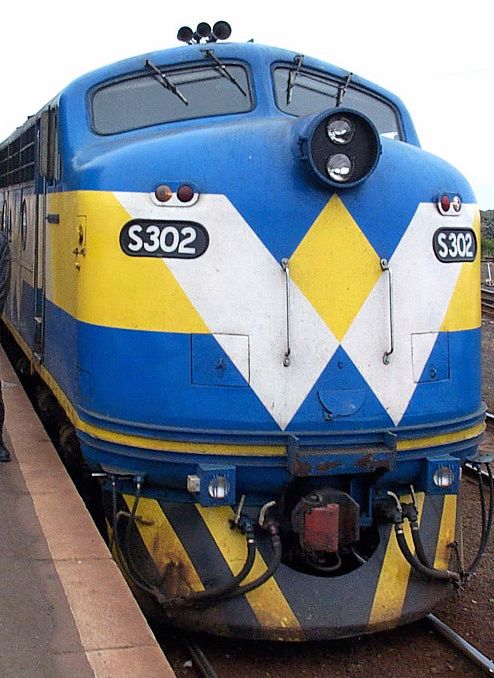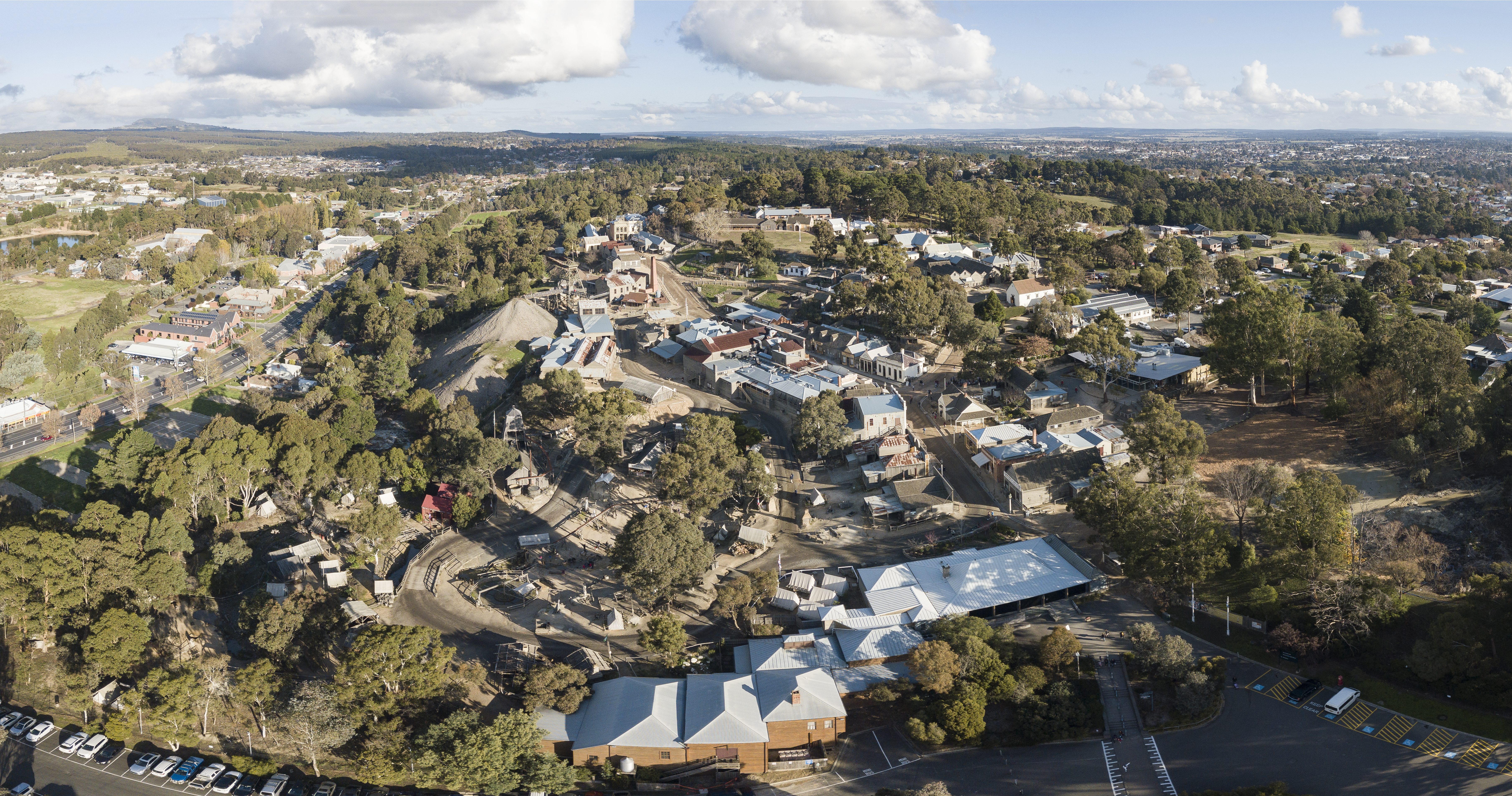|
Victorian Railways Y Class
The Victorian Railways Y class was a class of 0-6-0 steam locomotives. The Y class was an example of the new policy of standard design principles being adopted by the railways of the time. The original pattern locomotive (an 0-6-0 tender engine) was built by Kitson & Co. at Leeds in England in 1885, and was exhibited, along with E426, in 1888 at the Melbourne Centennial Exhibition, held in the Melbourne Exhibition Building. The other 30 locomotives of this type were built by the Phoenix Foundry at Ballarat in 1888-1889. They were given road numbers 383 to 441 (odd numbers only), and the pattern engine 445, 443 having been allotted to an "Old" R class. They were big locomotives for their time—in fact the largest and most powerful 0-6-0s to run in Australia. The class excelled in their performance and acceptance by crews. They were often seen on suburban passenger trains prior to electrification, finishing their lives as yard shunters. Withdrawal of the Y class began in ... [...More Info...] [...Related Items...] OR: [Wikipedia] [Google] [Baidu] |
0-6-0
Under the Whyte notation for the classification of steam locomotives, represents the wheel arrangement of no leading wheels, six powered and coupled driving wheels on three axles and no trailing wheels. This was the most common wheel arrangement used on both tender and tank locomotives in versions with both inside and outside cylinders. In the United Kingdom, the Whyte notation of wheel arrangement was also often used for the classification of electric and diesel-electric locomotives with side-rod coupled driving wheels. Under the UIC classification, popular in Europe, this wheel arrangement is written as C if the wheels are coupled with rods or gears, or Co if they are independently driven, the latter usually being electric and diesel-electric locomotives. Overview History The 0-6-0 configuration was the most widely used wheel arrangement for both tender and tank steam locomotives. The type was also widely used for diesel switchers (shunters). Because they lack lea ... [...More Info...] [...Related Items...] OR: [Wikipedia] [Google] [Baidu] |
Raak Plain
The Raak Plain Boinka is a wilderness area in the state of Victoria, Australia. The boinka groundwater discharge complex is a shallow depression within a region of Mallee dune fields, and contains gypsum flats and salinas, pools of salty water that are mainly fed by groundwater. The distinctive flora of the boinka is largely intact and includes several threatened species. Location The Raak Plain boinka is the largest boinka in the Murray River basin at about , and is an excellent example of a rare type of geological formation. It is northwest of Hattah, Victoria. The boinka complex lies to the east of the Sunset Strip, a NE-SW trending elevated block on the west of the Danyo Fault. The boinka is north of Mount Cowra and Wymlet. The Calder Highway running from north to south through Nowingi defines the eastern boundary. The Hattah-Kulkyne National Park lies to the east of the highway. The boinka lies within part of the Murray Mallee plain. There is a fringe of Lowan Mallee alo ... [...More Info...] [...Related Items...] OR: [Wikipedia] [Google] [Baidu] |
Railway Locomotives Introduced In 1885
Rail transport (also known as train transport) is a means of transport that transfers passengers and goods on wheeled vehicles running on rails, which are incorporated in tracks. In contrast to road transport, where the vehicles run on a prepared flat surface, rail vehicles (rolling stock) are directionally guided by the tracks on which they run. Tracks usually consist of steel rails, installed on sleepers (ties) set in ballast, on which the rolling stock, usually fitted with metal wheels, moves. Other variations are also possible, such as "slab track", in which the rails are fastened to a concrete foundation resting on a prepared subsurface. Rolling stock in a rail transport system generally encounters lower frictional resistance than rubber-tyred road vehicles, so passenger and freight cars (carriages and wagons) can be coupled into longer trains. The operation is carried out by a railway company, providing transport between train stations or freight customer facil ... [...More Info...] [...Related Items...] OR: [Wikipedia] [Google] [Baidu] |
Victorian Railways Locomotives
Victorian or Victorians may refer to: 19th century * Victorian era, British history during Queen Victoria's 19th-century reign ** Victorian architecture ** Victorian house ** Victorian decorative arts ** Victorian fashion ** Victorian literature ** Victorian morality ** Victoriana Other * ''The Victorians'', a 2009 British documentary * Victorian, a resident of the state of Victoria, Australia * Victorian, a resident of the provincial capital city of Victoria, British Columbia, Canada * RMS ''Victorian'', a ship * Saint Victorian (other), various saints * Victorian (horse) * Victorian Football Club (other), either of two defunct Australian rules football clubs See also * Neo-Victorian, a late 20th century aesthetic movement * Queen Victoria * Victoria (other) Victoria most commonly refers to: * Victoria (Australia), a state of the Commonwealth of Australia * Victoria, British Columbia, provincial capital of British Columbia, Canada * Victoria ... [...More Info...] [...Related Items...] OR: [Wikipedia] [Google] [Baidu] |
Nowingi Railway Station
Nowingi is a locality in Victoria, Australia, approximately south of Mildura. It is in the local government area of the Rural City of Mildura. History In May 2004, unreserved Crown land, roughly five kilometres south of Nowingi, was declared the Government's preferred site for the state's hazardous industrial waste using a long-term waste containment facility. The plan was cancelled however, when local protesters marched to Parliament House forcing the Government to look elsewhere. The Minister for Planning's Assessment and Panel Inquiry report found the proposal environmentally feasible but recommended against it based on strategic planning issues. The site is a small enclave of state forest surrounded by national park, and contains habitat important to a number of threatened species. Its hydrological composition was disputed, the Environmental Effects Statement (EES) investigations and subsequent evidence predicted that contaminated moisture would take greater than 100 ... [...More Info...] [...Related Items...] OR: [Wikipedia] [Google] [Baidu] |
North Melbourne Locomotive Depot
North Melbourne Locomotive Depot was the main location for maintenance of the Victorian Railways steam locomotive fleet based in Melbourne. Located in the middle of the Melbourne Yard precinct in the suburb West Melbourne, Victoria, West Melbourne near North Melbourne railway station, North Melbourne station, the site is now occupied by the Melbourne Steel Terminal. The depot was described by railway employees as ''"the hub of the universe"'', ''"the VR's nearest approach to Inferno (Dante), Dante's Inferno"'', or ''"the Black Hole of Calcutta"'' depending on their disposition. History The depot was opened sometime in the 1880s by the Victorian Railways, replacing its first locomotive depot located in the Southern Cross railway station, Spencer Street station yard. It was located beside the Railway Canal, a section of Moonee Ponds Creek that enabled the direct unloading of coal transported by sea from New South Wales. The rectangular building was built of brick and iron with thre ... [...More Info...] [...Related Items...] OR: [Wikipedia] [Google] [Baidu] |
West Coast Railway (Victoria)
West Coast Railway was a passenger train company operating in Victoria, Australia that operated services between Melbourne and Warrnambool from September 1993 until August 2004. The travel time for the journey (Warrnambool – Melbourne) was around 3 hours. This is on average around 30 minutes quicker than the current journeys. History West Coast Railway was formed in 1993 when the Kennett State Government offered long-distance country rail services previously run by the government-owned operator V/Line to private operators. Bids were lodged in February 1993 and West Coast Railway was announced as the successful tender on 30 April the same year. The initial franchise was for eight years with operations commencing on 19 September 1993. Subsequently, a three-year extension was negotiated. While most other rail services tendered were replaced by road coach services, West Coast Railway successfully tendered to retain a rail service. During the 11 years of WCR operation of the line ... [...More Info...] [...Related Items...] OR: [Wikipedia] [Google] [Baidu] |
Sovereign Hill
Sovereign Hill is an open-air museum in Golden Point, a suburb of Ballarat, Victoria, Australia. Sovereign Hill depicts Ballarat's first ten years after the discovery of gold there in 1851. It was officially opened on 29 November 1970 and has become a nationally acclaimed tourist attraction. It is one of Victoria's most popular attractions and Ballarat's most famous. Set in the Australian 1850s, the complex is located on a 25-hectare site that is linked to the richest alluvial gold rush in the world. The site comprises over 60 historically recreated buildings, with costumed staff and volunteers, who are able to answer questions and will pose for photos. The recreation is completed with antiques, artwork, books and papers, machinery, livestock and animals, carriages, and devices all appropriate to the era. History The second-largest gold nugget in the world was found in Ballarat in the Red Hill Mine which is recreated in Sovereign Hill. The Welcome Nugget weighed 69 kg,( ... [...More Info...] [...Related Items...] OR: [Wikipedia] [Google] [Baidu] |
Ballarat Railway Station
Ballarat railway station is located on the Serviceton line in Victoria, Australia. It serves the city of Ballarat, and it opened on 11 April 1862 as Ballarat West. It was renamed Ballarat in 1865.Ballarat Vicsig Located about from the state capital, , it is considered a major station on the Serviceton line. The extensive building complex is of major architectural and historical significance to Ballarat; most of its original 19th-century features are intact. Preserved historic features include signal boxes, |
Meringur
Meringur is a farming settlement to the west of Mildura in northwestern Victoria, Australia. At the 2016 census, Meringur and the surrounding area had a population of 67 down from 128 in 2011. It is located in the Millewa region at the end of the Red Cliffs-Meringur Road towards the South Australian border. The Post Office opened on 2 February 1926. The railway opened in 1925, and the station had facilities to handle passengers, sheep and grain. The line was extended to Morkalla in 1931, but the extension closed in 1965. The entire line was closed by 1988. The Millewa Pioneer Forest and Historical Village open-air museum is in Meringur. Meringur has an Australian rules football team competing in the Millewa Football League The Millewa Football League is an Australian rules football league with teams based in north-western Victoria and south-western New South Wales, Australia. The clubs are mostly based within the same area as the clubs in the Sunraysia Football L ..., ... [...More Info...] [...Related Items...] OR: [Wikipedia] [Google] [Baidu] |
Ballarat East, Victoria
Ballarat East is a suburb of Ballarat in Victoria, Australia. From 1857 until 1921 the suburb had its own council (see below). The suburb covers a large area east of the city centre. It is the oldest urban area in Ballarat and was the site of many goldmines, as well as of the Eureka Rebellion. The population of Ballarat East at the was 5,937, making it the 4th most populated suburb in the Ballarat area. The former town retains much of its shambolic character, particularly its winding, unplanned streets, which arose organically among the many gold mines. Much of the suburb is subject to heritage protection because of its local historical significance, with many dwellings dating from between the 1860s and 1940s. History In the 1840s, the Yuille cousins, who were the first colonists to own land in the region of Ballarat, operated their farm from the rich alluvial plain at the base of Black Hill and south of the Yarrowee River. According to historian Weston Bate, the soil was ... [...More Info...] [...Related Items...] OR: [Wikipedia] [Google] [Baidu] |
.jpg)



